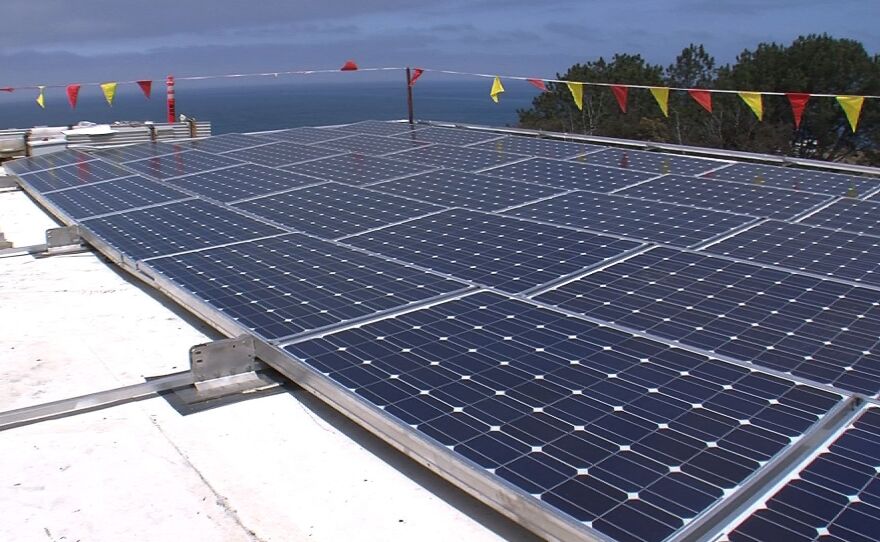Gabe Von Wellsheim lifted up a solar panel destined for a San Diego rooftop.
“So this is glass and then the cells are actually behind the glass. And it's all enclosed from the back,” he said.
Von Wellsheim founded Aloha Solar two years ago and business is brisk. An installation in Del Mar will be up and running in a day, and the company has another crew working on a different project.

There is consumer interest in solar because it saves money and helps the environment, but there are possibly some big changes coming.
RELATED: California's solar marketplace could see some major changes soon
California’s investor-owned utilities are quietly pushing hard for major reforms in the system designed to encourage more state residents to pay for solar panels on their roofs.
The California Public Utilities Commission set up rules for solar — known as net energy metering — which locks in the price of electricity that residents sell back to utilities. And the current version also requires a small monthly fee to pay for fixed costs.
“They hire PR firms with millions of dollars to spend and they effectively shape the whole debate and take something that’s kind of confusing and make it seem like it’s a very difficult decision.”— Bernadette Del Chiarro
“It’s an agreement that’s pretty favorable for solar customers right now,” Von Wellshiem said. “And then net metering 3.0 is the next phase and there is some uncertainty if it’ll be, it’ll definitely be less favorable, how less favorable is to be determined.”
California’s three investor-owned utilities are asking for major changes.
The companies want to slash the price of electricity they are required to pay when they buy solar-generated electricity from homeowners.
They also propose charging a steep recurring fee, as much as $90 a month, just to connect to the grid.
The utilities argue solar customers are saving money at the expense of their neighbors, in essence shifting the cost of maintaining the grid to customers that do not have solar.
San Diego Gas & Electric declined to discuss its position, instead steering KPBS to surrogates like The Utility Reform Network, or TURN.
“For future solar customers, let’s bring the subsidy in alignment with the fact that the cost of solar installations are dramatically less than they were once upon a time,” said Mark Toney, the executive director of TURN.
RELATED: California Assembly Debating Solar Energy Reforms
The utility consumer group says the solar subsidy needs to be cut in California because that state’s electricity prices are already some of the most expensive in the nation.
TURN says those costs could come down for all customers if the solar subsidy is cut back.
“In San Diego we estimate that’s about $260 a year,” Toney said. “Non-solar customers are paying extra. And what we’d like to see is that we’d like to bring that down so that the customers who don’t own solar get a little bit of a break because prices are just too high.”
The cost shift argument is a common talking point for groups like TURN and the Natural Resources Defense Council, NRDC, which have aligned their reform proposals with the utilities.
Both groups and the utilities argue that electric customers without solar pay higher prices for electricity because solar customers are buying less.
That allows solar customers to avoid paying for grid maintenance, transmission lines, and wildfire mitigation, costs which are baked into the rates, according to that line of argument.
The NRDC estimates only about 15% of the retail cost of a kilowatt hour pays for solar subsidies. It acknowledges there are other fixed costs, unrelated to the cost of buying and selling electricity.
RELATED: Changes To California Solar Market Are Dead For Now
Solar industry advocates say adopting those changes would crush the financial incentive to go solar and make it harder for California to reach its greenhouse gas reduction goals.
They say the utilities are flexing their financial muscles.
“They have so much power and influence,” said Bernadette Del Chiarro, the executive director of the California Solar & Storage Association. “They hire PR firms with millions of dollars to spend and they effectively shape the whole debate and take something that’s kind of confusing and make it seem like it’s a very difficult decision.”
While KPBS couldn’t ask SDGE any questions, the company did email a statement. Utility officials said they have been working on net energy metering reforms for the past year and they are eager to see the system’s inequities addressed.
Solar advocates are not buying that.
“Instead of looking at how to improve upon net metering, and make it better for people with lower income, people in apartment buildings, people that are faced with repeated grid outages. Instead, they’re saying, let’s just take a guillotine to this problem and make solar twice as expensive and completely inaccessible to everybody,” she said.
Any solar market reforms being considered, will not be finalized until early next year and any preliminary plans could change before the California Public Utilities Commission votes on them.





